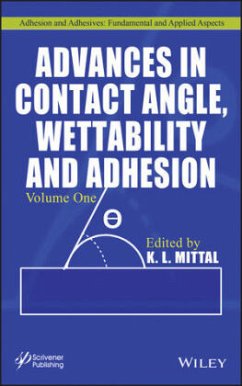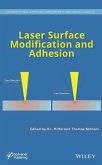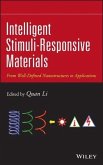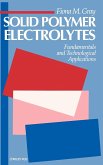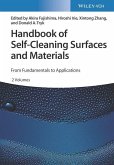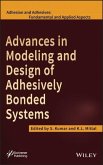Kashmiri L. Mittal
Advances in Contact Angle, Wettability and Adhesion, Volume 1
Herausgeber: Mittal, K L
Kashmiri L. Mittal
Advances in Contact Angle, Wettability and Adhesion, Volume 1
Herausgeber: Mittal, K L
- Gebundenes Buch
- Merkliste
- Auf die Merkliste
- Bewerten Bewerten
- Teilen
- Produkt teilen
- Produkterinnerung
- Produkterinnerung
The topic of wettabilty is extremely important from both fundamental and applied aspects. The applications of wettability range from self-cleaning windows to micro- and nanofluidics.
This book represents the cumulative wisdom of a contingent of world-class (researchers engaged in the domain of wettability. In the last few years there has been tremendous interest in the "Lotus Leaf Effect" and in understanding its mechanism and how to replicate this effect for myriad applications. The topics of superhydrophobicity, omniphobicity and superhydrophilicity are of much contemporary interest and these are covered in depth in this book.…mehr
Andere Kunden interessierten sich auch für
![Foam Engineering Foam Engineering]() Foam Engineering219,99 €
Foam Engineering219,99 €![Laser Surface Modification and Adhesion Laser Surface Modification and Adhesion]() K. L. MittalLaser Surface Modification and Adhesion235,99 €
K. L. MittalLaser Surface Modification and Adhesion235,99 €![Intelligent Stimuli-Responsive Materials Intelligent Stimuli-Responsive Materials]() Intelligent Stimuli-Responsive Materials219,99 €
Intelligent Stimuli-Responsive Materials219,99 €![Solid Polymer Electrolytes Solid Polymer Electrolytes]() Fiona M GraySolid Polymer Electrolytes289,99 €
Fiona M GraySolid Polymer Electrolytes289,99 €![Integration of Ferroelectric and Piezoelectric Thin Films Integration of Ferroelectric and Piezoelectric Thin Films]() Emmanuel Defa˙Integration of Ferroelectric and Piezoelectric Thin Films255,99 €
Emmanuel Defa˙Integration of Ferroelectric and Piezoelectric Thin Films255,99 €![Handbook of Self-Cleaning Surfaces and Materials Handbook of Self-Cleaning Surfaces and Materials]() Handbook of Self-Cleaning Surfaces and Materials221,99 €
Handbook of Self-Cleaning Surfaces and Materials221,99 €![Advances in Modeling and Design of Adhesively Bonded Systems Advances in Modeling and Design of Adhesively Bonded Systems]() Advances in Modeling and Design of Adhesively Bonded Systems241,99 €
Advances in Modeling and Design of Adhesively Bonded Systems241,99 €-
-
-
The topic of wettabilty is extremely important from both fundamental and applied aspects. The applications of wettability range from self-cleaning windows to micro- and nanofluidics.
This book represents the cumulative wisdom of a contingent of world-class (researchers engaged in the domain of wettability. In the last few years there has been tremendous interest in the "Lotus Leaf Effect" and in understanding its mechanism and how to replicate this effect for myriad applications. The topics of superhydrophobicity, omniphobicity and superhydrophilicity are of much contemporary interest and these are covered in depth in this book.
Hinweis: Dieser Artikel kann nur an eine deutsche Lieferadresse ausgeliefert werden.
This book represents the cumulative wisdom of a contingent of world-class (researchers engaged in the domain of wettability. In the last few years there has been tremendous interest in the "Lotus Leaf Effect" and in understanding its mechanism and how to replicate this effect for myriad applications. The topics of superhydrophobicity, omniphobicity and superhydrophilicity are of much contemporary interest and these are covered in depth in this book.
Hinweis: Dieser Artikel kann nur an eine deutsche Lieferadresse ausgeliefert werden.
Produktdetails
- Produktdetails
- Advances in Contact Angle, Wettability and Adhesion Vol.1
- Verlag: Wiley & Sons
- 1. Auflage
- Seitenzahl: 440
- Erscheinungstermin: 22. Juli 2013
- Englisch
- Abmessung: 236mm x 157mm x 28mm
- Gewicht: 717g
- ISBN-13: 9781118472927
- ISBN-10: 1118472926
- Artikelnr.: 36395747
- Herstellerkennzeichnung
- Libri GmbH
- Europaallee 1
- 36244 Bad Hersfeld
- gpsr@libri.de
- Advances in Contact Angle, Wettability and Adhesion Vol.1
- Verlag: Wiley & Sons
- 1. Auflage
- Seitenzahl: 440
- Erscheinungstermin: 22. Juli 2013
- Englisch
- Abmessung: 236mm x 157mm x 28mm
- Gewicht: 717g
- ISBN-13: 9781118472927
- ISBN-10: 1118472926
- Artikelnr.: 36395747
- Herstellerkennzeichnung
- Libri GmbH
- Europaallee 1
- 36244 Bad Hersfeld
- gpsr@libri.de
Kashmiri Lal Mittal was employed by the IBM Corporation from 1972 through 1993. Currently, he is teaching and consulting worldwide in the broad areas of adhesion as well as surface cleaning. He has received numerous awards and honors including the title of doctor honoris causa from Maria Curie-Sk¿odowska University, Lublin, Poland. He is the editor of more than 110 books dealing with adhesion measurement, adhesion of polymeric coatings, polymer surfaces, adhesive joints, adhesion promoters, thin films, polyimides, surface modification, surface cleaning, and surfactants. Dr. Mittal is also the Founding Editor of the journal Reviews of Adhesion and Adhesives.
Preface xvii
Acknowledgements xxi
Part 1: Fundamental Aspects 1
1 Correlation between Contact Line Pinning and Contact Angle Hysteresis on
Heterogeneous Surfaces: A Review and Discussion 3
Mohammad Amin Sarshar, Wei Xu, and Chang-Hwan Choi
1.1 Introduction 3
1.2 Contact Line Pinning on Chemically Heterogeneous Flat Surfaces 4
1.3 Contact Line Pinning on Hydrophobic Structured Surfaces 7
1.4 Summary and Conclusion 14
2 Computational and Experimental Study of Contact Angle Hysteresis in
Multiphase Systems 19
Vahid Mortazavi, Vahid Hejazi, Roshan M D'Souza, and Michael Nosonovsky
2.1 Introduction 19
2.2 Origins of the CA Hysteresis 24
2.3 Modeling Wetting/Dewetting in Multiphase Systems 27
2.4 Experimental Observations 30
2.5 Numerical Modeling of CA Hysteresis 35
2.6 Conclusions 44
3 Heterogeneous Nucleation on a Completely Wettable Substrate 49
Masao Iwamatsu
3.1 Introduction 49
3.2 Interface-Displacement Model 51
3.3 Nucleation on a Completely-Wettable Flat Substrate 54
3.4 Nucleation on a Completely-Wettable Spherical Substrate 65
3.5 Conclusion 69
4 Local Wetting at Contact Line on Textured Hydrophobic Surfaces 73
Ri Li and Yanguang Shan
4.1 Introduction 73
4.2 Static Contact Angle 76
4.3 Wetting of Single Texture Element 80
4.4 Summary 85
5 Fundamental Understanding of Drops Wettability Behavior Theoretically and
Experimentally 87
Hartmann E. N'guessan, Robert White, Aisha Leh, Arnab Baksi, and Rafael
Tadmor
5.1 Introduction 87
5.2 Discussion 90
5.3 Conclusion 93
6 Hierarchical Structures Obtained by Breath Figures Self-Assembly and
Chemical Etching and their Wetting Properties 97
Edward Bormashenko, Sagi Balter, Roman Grynyov, and Doron Aurbach
6.1 Introduction 97
6.2 Materials and Methods 98
6.3 Results and Discussion 100
6.4 Conclusions 105
7 Computational Aspects of Self-Cleaning Surface Mechanisms 109
Muhammad Osman, Raheel Rasool, and Roger A. Sauer
7.1 Introduction 109
7.2 Droplet Membrane 111
7.3 Flow Model 121
7.4 Results 126
7.5 Summary 129
8 Study of Material-Water Interactions Using the Wilhelmy Plate Method 131
Eric Tomasetti, Sylvie Derclaye, Mary-Hélène Delvaux, and Paul G. Rouxhet
8.1 Introduction 132
8.2 Upgrading Wetting Curves 133
8.3 Study of Surface-Oxidized Polyethylene 136
8.4 Study of Amphiphilic UV-Cured Coatings 143
8.5 Conclusion 151
9 On the Utility of Imaginary Contact Angles in the Characterization of
Wettability of Rough Medicinal Hydrophilic Titanium 155
S. Lüers, C. Seitz, M. Laub, and H.P. Jennissen
9.1 Introduction 156
9.2 Theoretical Considerations 156
9.3 Materials and Methods 158
9.4 Results and Discussion 161
9.5 Conclusion 171
10 Determination of Surface Free Energy at the Nanoscale via Atomic Force
Microscopy without Altering the Original Morphology 173
L. Mazzola and A. Galderisi
10.1 Introduction 174
10.2 Materials and Methods 175
10.3 Results and Discussion 180
10.4 Conclusion 188
Part 2: Superhydrophobic Surfaces 191
11 Assessment Criteria for Superhydrophobic Surfaces with Stochastic
Roughness 193
Angela Duparré and Luisa Coriand
11.1 Introduction 193
11.2 Model and Experiments 194
11.3 Results and Discussion 197
11.4 Summary 200
12 Nanostructured Lubricated Silver Flake/Polymer Composites Exhibiting
Robust Superhydrophobicity 203
Ilker S. Bayer, Luigi Martiradonna, and Athanassia Athanassiou
12.1 Introduction 204
12.2 Experimental 210
12.3 Results and Discussion 214
12.4 Conclusions 220
13 Local Wetting Modifi cation on Carnauba Wax-Coated Hierarchical Surfaces
by Infrared Laser Treatment 227
Athanasios Milionis, Roberta Ruffi lli, Ilker S. Bayer, Lorenzo Dominici,
Despina Fragouli, and Athanassia Athanassiou
13.1 Introduction 228
13.2 Experimental 229
13.3 Results and Discussion 231
13.4 Conclusions 238
Part 3: Wettability Modifi cation 243
14 Cold Radiofrequency Plasma Treatment Modifies Wettability and
Germination Rate of Plant Seeds 245
Edward Bormashenko, Roman Grynyov, Yelena Bormashenko, and Elyashiv Drori
14.1 Introduction 245
14.2 Experimental 246
14.3 Results and Discussion 248
14.4 Conclusions 255
15 Controlling the Wettability of Acrylate Coatings with Photo-Induced
Micro-Folding 259
Thomas Bahners, Lutz Prager, and Jochen S. Gutmann
15.1 Introduction 260
15.2 The Process of Photo-induced Micro-folding 264
15.3 Experimental 265
15.4 Review of Results 267
15.5 Summary 274
16 Influence of Surface Densification of Wood on its Dynamic Wettability
and Surface Free Energy 279
M. Petric, A. Kutnar, L. Rautkari, K. Laine, and M. Hughes
16.1 Introduction 280
16.2 Experimental 281
16.3 Results and Discussion 284
16.4 Summary and Conclusions 294
17 Contact Angle on Two Canadian Woods: Influence of Moisture Content and
Plane of Section 297
Fabio Tomczak and Bernard Riedl
17.1 Introduction 297
17.2 Materials and Experimental Procedures 300
17.3 Results and Discussion 302
17.4 Conclusions 307
18 Plasma Deposition of ZnO Thin Film on Sugar Maple: The Effect on Contact
Angle 311
Fabio Tomczak, Bernard Riedl, and Pierre Blanchet
18.1 Introduction 312
18.2 Materials and Experimental Procedures 313
18.3 Results and Discussion 316
18.4 Conclusion 325
19 Effect of Relative Humidity on Contact Angle and its Hysteresis on
Phospholipid DPPC Bilayer Deposited on Glass 329
Emil Chibowski, Konrad Terpilowski, and Lucyna Holysz
19.1 Introduction 330
19.2 Experimental 331
19.3 Result and Discussion 333
19.4 Conclusion 343
Part 4: Wettability and Surface Free Energy 347
20 Contact Angles and Surface Energy of Solids: Relevance and Limitations
349
Paul G. Rouxhet
20.1 Introduction 350
20.2 Thermodynamic Background 351
20.3 Determination of the Surface Energy of a Solid from Contact Angles 354
20.4 Wettability and Surface Composition of Polypropylene Modifi ed by
Oxidation 364
20.5 Wettability and Surface Cleanliness of Inorganic Materials 368
20.6 Conclusion 371
21 Surface Free Energy and Wettability of Different Oil and Gas Reservoir
Rocks 377
Andrei S. Zelenev and Nathan Lett
21.1 Introduction 377
21.2 Experimental 379
21.3 Results and Discussion 381
21.4 Conclusions 386
22 Influence of Surface Free Energy and Wettability on Friction Coefficient
between Tire and Road Surface in Wet Conditions 389
L. Mazzola, A. Galderisi, G. Fortunato, V. Ciaravola, and M. Giustiniano
22.1 Introduction 390
22.2 Theoretical Basis of the New Model 391
22.3 Materials and Methods 398
22.4 Results and Discussion 402
22.5 Summary and Conclusions 408
Acknowledgement 409
References 409
Acknowledgements xxi
Part 1: Fundamental Aspects 1
1 Correlation between Contact Line Pinning and Contact Angle Hysteresis on
Heterogeneous Surfaces: A Review and Discussion 3
Mohammad Amin Sarshar, Wei Xu, and Chang-Hwan Choi
1.1 Introduction 3
1.2 Contact Line Pinning on Chemically Heterogeneous Flat Surfaces 4
1.3 Contact Line Pinning on Hydrophobic Structured Surfaces 7
1.4 Summary and Conclusion 14
2 Computational and Experimental Study of Contact Angle Hysteresis in
Multiphase Systems 19
Vahid Mortazavi, Vahid Hejazi, Roshan M D'Souza, and Michael Nosonovsky
2.1 Introduction 19
2.2 Origins of the CA Hysteresis 24
2.3 Modeling Wetting/Dewetting in Multiphase Systems 27
2.4 Experimental Observations 30
2.5 Numerical Modeling of CA Hysteresis 35
2.6 Conclusions 44
3 Heterogeneous Nucleation on a Completely Wettable Substrate 49
Masao Iwamatsu
3.1 Introduction 49
3.2 Interface-Displacement Model 51
3.3 Nucleation on a Completely-Wettable Flat Substrate 54
3.4 Nucleation on a Completely-Wettable Spherical Substrate 65
3.5 Conclusion 69
4 Local Wetting at Contact Line on Textured Hydrophobic Surfaces 73
Ri Li and Yanguang Shan
4.1 Introduction 73
4.2 Static Contact Angle 76
4.3 Wetting of Single Texture Element 80
4.4 Summary 85
5 Fundamental Understanding of Drops Wettability Behavior Theoretically and
Experimentally 87
Hartmann E. N'guessan, Robert White, Aisha Leh, Arnab Baksi, and Rafael
Tadmor
5.1 Introduction 87
5.2 Discussion 90
5.3 Conclusion 93
6 Hierarchical Structures Obtained by Breath Figures Self-Assembly and
Chemical Etching and their Wetting Properties 97
Edward Bormashenko, Sagi Balter, Roman Grynyov, and Doron Aurbach
6.1 Introduction 97
6.2 Materials and Methods 98
6.3 Results and Discussion 100
6.4 Conclusions 105
7 Computational Aspects of Self-Cleaning Surface Mechanisms 109
Muhammad Osman, Raheel Rasool, and Roger A. Sauer
7.1 Introduction 109
7.2 Droplet Membrane 111
7.3 Flow Model 121
7.4 Results 126
7.5 Summary 129
8 Study of Material-Water Interactions Using the Wilhelmy Plate Method 131
Eric Tomasetti, Sylvie Derclaye, Mary-Hélène Delvaux, and Paul G. Rouxhet
8.1 Introduction 132
8.2 Upgrading Wetting Curves 133
8.3 Study of Surface-Oxidized Polyethylene 136
8.4 Study of Amphiphilic UV-Cured Coatings 143
8.5 Conclusion 151
9 On the Utility of Imaginary Contact Angles in the Characterization of
Wettability of Rough Medicinal Hydrophilic Titanium 155
S. Lüers, C. Seitz, M. Laub, and H.P. Jennissen
9.1 Introduction 156
9.2 Theoretical Considerations 156
9.3 Materials and Methods 158
9.4 Results and Discussion 161
9.5 Conclusion 171
10 Determination of Surface Free Energy at the Nanoscale via Atomic Force
Microscopy without Altering the Original Morphology 173
L. Mazzola and A. Galderisi
10.1 Introduction 174
10.2 Materials and Methods 175
10.3 Results and Discussion 180
10.4 Conclusion 188
Part 2: Superhydrophobic Surfaces 191
11 Assessment Criteria for Superhydrophobic Surfaces with Stochastic
Roughness 193
Angela Duparré and Luisa Coriand
11.1 Introduction 193
11.2 Model and Experiments 194
11.3 Results and Discussion 197
11.4 Summary 200
12 Nanostructured Lubricated Silver Flake/Polymer Composites Exhibiting
Robust Superhydrophobicity 203
Ilker S. Bayer, Luigi Martiradonna, and Athanassia Athanassiou
12.1 Introduction 204
12.2 Experimental 210
12.3 Results and Discussion 214
12.4 Conclusions 220
13 Local Wetting Modifi cation on Carnauba Wax-Coated Hierarchical Surfaces
by Infrared Laser Treatment 227
Athanasios Milionis, Roberta Ruffi lli, Ilker S. Bayer, Lorenzo Dominici,
Despina Fragouli, and Athanassia Athanassiou
13.1 Introduction 228
13.2 Experimental 229
13.3 Results and Discussion 231
13.4 Conclusions 238
Part 3: Wettability Modifi cation 243
14 Cold Radiofrequency Plasma Treatment Modifies Wettability and
Germination Rate of Plant Seeds 245
Edward Bormashenko, Roman Grynyov, Yelena Bormashenko, and Elyashiv Drori
14.1 Introduction 245
14.2 Experimental 246
14.3 Results and Discussion 248
14.4 Conclusions 255
15 Controlling the Wettability of Acrylate Coatings with Photo-Induced
Micro-Folding 259
Thomas Bahners, Lutz Prager, and Jochen S. Gutmann
15.1 Introduction 260
15.2 The Process of Photo-induced Micro-folding 264
15.3 Experimental 265
15.4 Review of Results 267
15.5 Summary 274
16 Influence of Surface Densification of Wood on its Dynamic Wettability
and Surface Free Energy 279
M. Petric, A. Kutnar, L. Rautkari, K. Laine, and M. Hughes
16.1 Introduction 280
16.2 Experimental 281
16.3 Results and Discussion 284
16.4 Summary and Conclusions 294
17 Contact Angle on Two Canadian Woods: Influence of Moisture Content and
Plane of Section 297
Fabio Tomczak and Bernard Riedl
17.1 Introduction 297
17.2 Materials and Experimental Procedures 300
17.3 Results and Discussion 302
17.4 Conclusions 307
18 Plasma Deposition of ZnO Thin Film on Sugar Maple: The Effect on Contact
Angle 311
Fabio Tomczak, Bernard Riedl, and Pierre Blanchet
18.1 Introduction 312
18.2 Materials and Experimental Procedures 313
18.3 Results and Discussion 316
18.4 Conclusion 325
19 Effect of Relative Humidity on Contact Angle and its Hysteresis on
Phospholipid DPPC Bilayer Deposited on Glass 329
Emil Chibowski, Konrad Terpilowski, and Lucyna Holysz
19.1 Introduction 330
19.2 Experimental 331
19.3 Result and Discussion 333
19.4 Conclusion 343
Part 4: Wettability and Surface Free Energy 347
20 Contact Angles and Surface Energy of Solids: Relevance and Limitations
349
Paul G. Rouxhet
20.1 Introduction 350
20.2 Thermodynamic Background 351
20.3 Determination of the Surface Energy of a Solid from Contact Angles 354
20.4 Wettability and Surface Composition of Polypropylene Modifi ed by
Oxidation 364
20.5 Wettability and Surface Cleanliness of Inorganic Materials 368
20.6 Conclusion 371
21 Surface Free Energy and Wettability of Different Oil and Gas Reservoir
Rocks 377
Andrei S. Zelenev and Nathan Lett
21.1 Introduction 377
21.2 Experimental 379
21.3 Results and Discussion 381
21.4 Conclusions 386
22 Influence of Surface Free Energy and Wettability on Friction Coefficient
between Tire and Road Surface in Wet Conditions 389
L. Mazzola, A. Galderisi, G. Fortunato, V. Ciaravola, and M. Giustiniano
22.1 Introduction 390
22.2 Theoretical Basis of the New Model 391
22.3 Materials and Methods 398
22.4 Results and Discussion 402
22.5 Summary and Conclusions 408
Acknowledgement 409
References 409
Preface xvii
Acknowledgements xxi
Part 1: Fundamental Aspects 1
1 Correlation between Contact Line Pinning and Contact Angle Hysteresis on
Heterogeneous Surfaces: A Review and Discussion 3
Mohammad Amin Sarshar, Wei Xu, and Chang-Hwan Choi
1.1 Introduction 3
1.2 Contact Line Pinning on Chemically Heterogeneous Flat Surfaces 4
1.3 Contact Line Pinning on Hydrophobic Structured Surfaces 7
1.4 Summary and Conclusion 14
2 Computational and Experimental Study of Contact Angle Hysteresis in
Multiphase Systems 19
Vahid Mortazavi, Vahid Hejazi, Roshan M D'Souza, and Michael Nosonovsky
2.1 Introduction 19
2.2 Origins of the CA Hysteresis 24
2.3 Modeling Wetting/Dewetting in Multiphase Systems 27
2.4 Experimental Observations 30
2.5 Numerical Modeling of CA Hysteresis 35
2.6 Conclusions 44
3 Heterogeneous Nucleation on a Completely Wettable Substrate 49
Masao Iwamatsu
3.1 Introduction 49
3.2 Interface-Displacement Model 51
3.3 Nucleation on a Completely-Wettable Flat Substrate 54
3.4 Nucleation on a Completely-Wettable Spherical Substrate 65
3.5 Conclusion 69
4 Local Wetting at Contact Line on Textured Hydrophobic Surfaces 73
Ri Li and Yanguang Shan
4.1 Introduction 73
4.2 Static Contact Angle 76
4.3 Wetting of Single Texture Element 80
4.4 Summary 85
5 Fundamental Understanding of Drops Wettability Behavior Theoretically and
Experimentally 87
Hartmann E. N'guessan, Robert White, Aisha Leh, Arnab Baksi, and Rafael
Tadmor
5.1 Introduction 87
5.2 Discussion 90
5.3 Conclusion 93
6 Hierarchical Structures Obtained by Breath Figures Self-Assembly and
Chemical Etching and their Wetting Properties 97
Edward Bormashenko, Sagi Balter, Roman Grynyov, and Doron Aurbach
6.1 Introduction 97
6.2 Materials and Methods 98
6.3 Results and Discussion 100
6.4 Conclusions 105
7 Computational Aspects of Self-Cleaning Surface Mechanisms 109
Muhammad Osman, Raheel Rasool, and Roger A. Sauer
7.1 Introduction 109
7.2 Droplet Membrane 111
7.3 Flow Model 121
7.4 Results 126
7.5 Summary 129
8 Study of Material-Water Interactions Using the Wilhelmy Plate Method 131
Eric Tomasetti, Sylvie Derclaye, Mary-Hélène Delvaux, and Paul G. Rouxhet
8.1 Introduction 132
8.2 Upgrading Wetting Curves 133
8.3 Study of Surface-Oxidized Polyethylene 136
8.4 Study of Amphiphilic UV-Cured Coatings 143
8.5 Conclusion 151
9 On the Utility of Imaginary Contact Angles in the Characterization of
Wettability of Rough Medicinal Hydrophilic Titanium 155
S. Lüers, C. Seitz, M. Laub, and H.P. Jennissen
9.1 Introduction 156
9.2 Theoretical Considerations 156
9.3 Materials and Methods 158
9.4 Results and Discussion 161
9.5 Conclusion 171
10 Determination of Surface Free Energy at the Nanoscale via Atomic Force
Microscopy without Altering the Original Morphology 173
L. Mazzola and A. Galderisi
10.1 Introduction 174
10.2 Materials and Methods 175
10.3 Results and Discussion 180
10.4 Conclusion 188
Part 2: Superhydrophobic Surfaces 191
11 Assessment Criteria for Superhydrophobic Surfaces with Stochastic
Roughness 193
Angela Duparré and Luisa Coriand
11.1 Introduction 193
11.2 Model and Experiments 194
11.3 Results and Discussion 197
11.4 Summary 200
12 Nanostructured Lubricated Silver Flake/Polymer Composites Exhibiting
Robust Superhydrophobicity 203
Ilker S. Bayer, Luigi Martiradonna, and Athanassia Athanassiou
12.1 Introduction 204
12.2 Experimental 210
12.3 Results and Discussion 214
12.4 Conclusions 220
13 Local Wetting Modifi cation on Carnauba Wax-Coated Hierarchical Surfaces
by Infrared Laser Treatment 227
Athanasios Milionis, Roberta Ruffi lli, Ilker S. Bayer, Lorenzo Dominici,
Despina Fragouli, and Athanassia Athanassiou
13.1 Introduction 228
13.2 Experimental 229
13.3 Results and Discussion 231
13.4 Conclusions 238
Part 3: Wettability Modifi cation 243
14 Cold Radiofrequency Plasma Treatment Modifies Wettability and
Germination Rate of Plant Seeds 245
Edward Bormashenko, Roman Grynyov, Yelena Bormashenko, and Elyashiv Drori
14.1 Introduction 245
14.2 Experimental 246
14.3 Results and Discussion 248
14.4 Conclusions 255
15 Controlling the Wettability of Acrylate Coatings with Photo-Induced
Micro-Folding 259
Thomas Bahners, Lutz Prager, and Jochen S. Gutmann
15.1 Introduction 260
15.2 The Process of Photo-induced Micro-folding 264
15.3 Experimental 265
15.4 Review of Results 267
15.5 Summary 274
16 Influence of Surface Densification of Wood on its Dynamic Wettability
and Surface Free Energy 279
M. Petric, A. Kutnar, L. Rautkari, K. Laine, and M. Hughes
16.1 Introduction 280
16.2 Experimental 281
16.3 Results and Discussion 284
16.4 Summary and Conclusions 294
17 Contact Angle on Two Canadian Woods: Influence of Moisture Content and
Plane of Section 297
Fabio Tomczak and Bernard Riedl
17.1 Introduction 297
17.2 Materials and Experimental Procedures 300
17.3 Results and Discussion 302
17.4 Conclusions 307
18 Plasma Deposition of ZnO Thin Film on Sugar Maple: The Effect on Contact
Angle 311
Fabio Tomczak, Bernard Riedl, and Pierre Blanchet
18.1 Introduction 312
18.2 Materials and Experimental Procedures 313
18.3 Results and Discussion 316
18.4 Conclusion 325
19 Effect of Relative Humidity on Contact Angle and its Hysteresis on
Phospholipid DPPC Bilayer Deposited on Glass 329
Emil Chibowski, Konrad Terpilowski, and Lucyna Holysz
19.1 Introduction 330
19.2 Experimental 331
19.3 Result and Discussion 333
19.4 Conclusion 343
Part 4: Wettability and Surface Free Energy 347
20 Contact Angles and Surface Energy of Solids: Relevance and Limitations
349
Paul G. Rouxhet
20.1 Introduction 350
20.2 Thermodynamic Background 351
20.3 Determination of the Surface Energy of a Solid from Contact Angles 354
20.4 Wettability and Surface Composition of Polypropylene Modifi ed by
Oxidation 364
20.5 Wettability and Surface Cleanliness of Inorganic Materials 368
20.6 Conclusion 371
21 Surface Free Energy and Wettability of Different Oil and Gas Reservoir
Rocks 377
Andrei S. Zelenev and Nathan Lett
21.1 Introduction 377
21.2 Experimental 379
21.3 Results and Discussion 381
21.4 Conclusions 386
22 Influence of Surface Free Energy and Wettability on Friction Coefficient
between Tire and Road Surface in Wet Conditions 389
L. Mazzola, A. Galderisi, G. Fortunato, V. Ciaravola, and M. Giustiniano
22.1 Introduction 390
22.2 Theoretical Basis of the New Model 391
22.3 Materials and Methods 398
22.4 Results and Discussion 402
22.5 Summary and Conclusions 408
Acknowledgement 409
References 409
Acknowledgements xxi
Part 1: Fundamental Aspects 1
1 Correlation between Contact Line Pinning and Contact Angle Hysteresis on
Heterogeneous Surfaces: A Review and Discussion 3
Mohammad Amin Sarshar, Wei Xu, and Chang-Hwan Choi
1.1 Introduction 3
1.2 Contact Line Pinning on Chemically Heterogeneous Flat Surfaces 4
1.3 Contact Line Pinning on Hydrophobic Structured Surfaces 7
1.4 Summary and Conclusion 14
2 Computational and Experimental Study of Contact Angle Hysteresis in
Multiphase Systems 19
Vahid Mortazavi, Vahid Hejazi, Roshan M D'Souza, and Michael Nosonovsky
2.1 Introduction 19
2.2 Origins of the CA Hysteresis 24
2.3 Modeling Wetting/Dewetting in Multiphase Systems 27
2.4 Experimental Observations 30
2.5 Numerical Modeling of CA Hysteresis 35
2.6 Conclusions 44
3 Heterogeneous Nucleation on a Completely Wettable Substrate 49
Masao Iwamatsu
3.1 Introduction 49
3.2 Interface-Displacement Model 51
3.3 Nucleation on a Completely-Wettable Flat Substrate 54
3.4 Nucleation on a Completely-Wettable Spherical Substrate 65
3.5 Conclusion 69
4 Local Wetting at Contact Line on Textured Hydrophobic Surfaces 73
Ri Li and Yanguang Shan
4.1 Introduction 73
4.2 Static Contact Angle 76
4.3 Wetting of Single Texture Element 80
4.4 Summary 85
5 Fundamental Understanding of Drops Wettability Behavior Theoretically and
Experimentally 87
Hartmann E. N'guessan, Robert White, Aisha Leh, Arnab Baksi, and Rafael
Tadmor
5.1 Introduction 87
5.2 Discussion 90
5.3 Conclusion 93
6 Hierarchical Structures Obtained by Breath Figures Self-Assembly and
Chemical Etching and their Wetting Properties 97
Edward Bormashenko, Sagi Balter, Roman Grynyov, and Doron Aurbach
6.1 Introduction 97
6.2 Materials and Methods 98
6.3 Results and Discussion 100
6.4 Conclusions 105
7 Computational Aspects of Self-Cleaning Surface Mechanisms 109
Muhammad Osman, Raheel Rasool, and Roger A. Sauer
7.1 Introduction 109
7.2 Droplet Membrane 111
7.3 Flow Model 121
7.4 Results 126
7.5 Summary 129
8 Study of Material-Water Interactions Using the Wilhelmy Plate Method 131
Eric Tomasetti, Sylvie Derclaye, Mary-Hélène Delvaux, and Paul G. Rouxhet
8.1 Introduction 132
8.2 Upgrading Wetting Curves 133
8.3 Study of Surface-Oxidized Polyethylene 136
8.4 Study of Amphiphilic UV-Cured Coatings 143
8.5 Conclusion 151
9 On the Utility of Imaginary Contact Angles in the Characterization of
Wettability of Rough Medicinal Hydrophilic Titanium 155
S. Lüers, C. Seitz, M. Laub, and H.P. Jennissen
9.1 Introduction 156
9.2 Theoretical Considerations 156
9.3 Materials and Methods 158
9.4 Results and Discussion 161
9.5 Conclusion 171
10 Determination of Surface Free Energy at the Nanoscale via Atomic Force
Microscopy without Altering the Original Morphology 173
L. Mazzola and A. Galderisi
10.1 Introduction 174
10.2 Materials and Methods 175
10.3 Results and Discussion 180
10.4 Conclusion 188
Part 2: Superhydrophobic Surfaces 191
11 Assessment Criteria for Superhydrophobic Surfaces with Stochastic
Roughness 193
Angela Duparré and Luisa Coriand
11.1 Introduction 193
11.2 Model and Experiments 194
11.3 Results and Discussion 197
11.4 Summary 200
12 Nanostructured Lubricated Silver Flake/Polymer Composites Exhibiting
Robust Superhydrophobicity 203
Ilker S. Bayer, Luigi Martiradonna, and Athanassia Athanassiou
12.1 Introduction 204
12.2 Experimental 210
12.3 Results and Discussion 214
12.4 Conclusions 220
13 Local Wetting Modifi cation on Carnauba Wax-Coated Hierarchical Surfaces
by Infrared Laser Treatment 227
Athanasios Milionis, Roberta Ruffi lli, Ilker S. Bayer, Lorenzo Dominici,
Despina Fragouli, and Athanassia Athanassiou
13.1 Introduction 228
13.2 Experimental 229
13.3 Results and Discussion 231
13.4 Conclusions 238
Part 3: Wettability Modifi cation 243
14 Cold Radiofrequency Plasma Treatment Modifies Wettability and
Germination Rate of Plant Seeds 245
Edward Bormashenko, Roman Grynyov, Yelena Bormashenko, and Elyashiv Drori
14.1 Introduction 245
14.2 Experimental 246
14.3 Results and Discussion 248
14.4 Conclusions 255
15 Controlling the Wettability of Acrylate Coatings with Photo-Induced
Micro-Folding 259
Thomas Bahners, Lutz Prager, and Jochen S. Gutmann
15.1 Introduction 260
15.2 The Process of Photo-induced Micro-folding 264
15.3 Experimental 265
15.4 Review of Results 267
15.5 Summary 274
16 Influence of Surface Densification of Wood on its Dynamic Wettability
and Surface Free Energy 279
M. Petric, A. Kutnar, L. Rautkari, K. Laine, and M. Hughes
16.1 Introduction 280
16.2 Experimental 281
16.3 Results and Discussion 284
16.4 Summary and Conclusions 294
17 Contact Angle on Two Canadian Woods: Influence of Moisture Content and
Plane of Section 297
Fabio Tomczak and Bernard Riedl
17.1 Introduction 297
17.2 Materials and Experimental Procedures 300
17.3 Results and Discussion 302
17.4 Conclusions 307
18 Plasma Deposition of ZnO Thin Film on Sugar Maple: The Effect on Contact
Angle 311
Fabio Tomczak, Bernard Riedl, and Pierre Blanchet
18.1 Introduction 312
18.2 Materials and Experimental Procedures 313
18.3 Results and Discussion 316
18.4 Conclusion 325
19 Effect of Relative Humidity on Contact Angle and its Hysteresis on
Phospholipid DPPC Bilayer Deposited on Glass 329
Emil Chibowski, Konrad Terpilowski, and Lucyna Holysz
19.1 Introduction 330
19.2 Experimental 331
19.3 Result and Discussion 333
19.4 Conclusion 343
Part 4: Wettability and Surface Free Energy 347
20 Contact Angles and Surface Energy of Solids: Relevance and Limitations
349
Paul G. Rouxhet
20.1 Introduction 350
20.2 Thermodynamic Background 351
20.3 Determination of the Surface Energy of a Solid from Contact Angles 354
20.4 Wettability and Surface Composition of Polypropylene Modifi ed by
Oxidation 364
20.5 Wettability and Surface Cleanliness of Inorganic Materials 368
20.6 Conclusion 371
21 Surface Free Energy and Wettability of Different Oil and Gas Reservoir
Rocks 377
Andrei S. Zelenev and Nathan Lett
21.1 Introduction 377
21.2 Experimental 379
21.3 Results and Discussion 381
21.4 Conclusions 386
22 Influence of Surface Free Energy and Wettability on Friction Coefficient
between Tire and Road Surface in Wet Conditions 389
L. Mazzola, A. Galderisi, G. Fortunato, V. Ciaravola, and M. Giustiniano
22.1 Introduction 390
22.2 Theoretical Basis of the New Model 391
22.3 Materials and Methods 398
22.4 Results and Discussion 402
22.5 Summary and Conclusions 408
Acknowledgement 409
References 409

